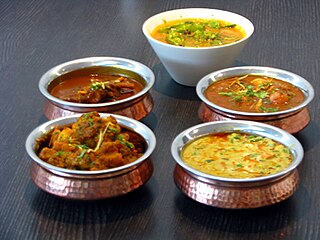
Curry is a dish with a sauce seasoned with spices, mainly associated with South Asian cuisine. It is not to be confused with leaves from the curry tree, though some curries do include curry leaves. Curry is also found in the native cuisines of many South East Asian and East Asian countries due to ancient contact with South Asia.

English cuisine encompasses the cooking styles, traditions and recipes associated with England. It has distinctive attributes of its own, but is also very similar to wider British cuisine, partly historically and partly due to the import of ingredients and ideas from the Americas, China, and India during the time of the British Empire and as a result of post-war immigration.

Chicken tikka masala is a dish consisting of roasted marinated chicken chunks in a spiced sauce. The sauce is usually creamy and orange-coloured. The dish was popularised by cooks from India living in Great Britain and is offered at restaurants around the world.

Pakistani cuisine can be characterized as a blend of regional cooking styles and flavours from across South, Central and Western Asia. Pakistani cuisine is influenced by Persian, Indian, and Arab cuisine. The cuisine of Pakistan also maintains certain Mughal influences within its recipes and cooking techniques. Pakistan's ethnic and cultural diversity, diverse climates, geographical environments, and availability of different produce lead to diverse regional cuisines.
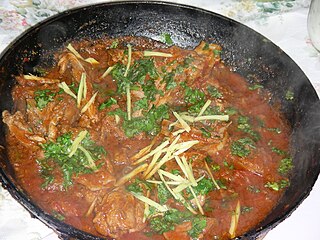
A balti or bāltī gosht is a type of curry served in a thin, pressed-steel wok called a "balti bowl". The name may have come from the metal dish in which the curry is cooked, rather than from any specific ingredient or cooking technique. Balti curries are cooked quickly using vegetable oil rather than ghee, over high heat in the manner of a stir-fry, and any meat is used off the bone. This combination differs sharply from a traditional one-pot Indian curry which is simmered slowly all day. Balti sauce is based on garlic and onions, with turmeric and garam masala, among other spices.

Punjabi cuisine is a culinary style originating in the Punjab, a region in the northern part of South Asia, which is now divided in an Indian part to the east and a Pakistani part to the west. This cuisine has a rich tradition of many distinct and local ways of cooking.
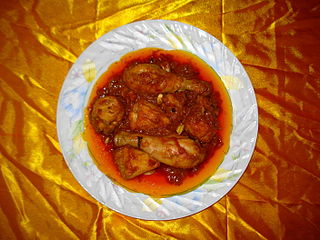
Korma or qorma ; Persian: قرما); is a dish with its origin in the Indian subcontinent, consisting of meat or vegetables braised with yogurt (dahi), water or stock, and spices to produce a thick sauce or gravy.

Butter chicken, traditionally known as murgh makhani, is an Indian dish originating in Delhi. It is a type of curry made from chicken with a spiced tomato and butter (makhan) sauce. Its sauce is known for its rich texture. It is similar to chicken tikka masala, which uses a tomato paste.

Tandoori chicken is a dish made from chicken marinated in yogurt and spices and roasted in a tandoor, a cylindrical clay oven. The dish is now popular worldwide. The modern form of the dish was popularized by the Moti Mahal restaurant in New Delhi, India in the late 1940s.
Anglo-Indian cuisine is the cuisine that developed during the British Raj in India. The cuisine introduced dishes such as curry, chutney, kedgeree, mulligatawny and pish pash to English palates.

Chicken tikka is a chicken dish popularised in the Indian subcontinent popular in India, Bangladesh, Pakistan and the United Kingdom. It is traditionally small pieces of boneless chicken baked using skewers on a brazier called angeethi or over charcoal after marinating in Indian spices and dahi (yogurt)—essentially a boneless version of tandoori chicken. The word tikka is a Persian word, meaning "bits" or "pieces". It is also a chicken dish served in Punjabi cuisine. The Kashmiri version of the dish, however, is grilled over red-hot coals, and does not always contain boneless pieces. The pieces are brushed with ghee at intervals to increase its flavour, while being continuously fanned. It is typically eaten with green coriander and tamarind chutney served with onion rings and lemon, or used in preparing an authentic chicken tikka masala.

Tandoori masala or tandoori sauce is a mixture of spices specifically for use with a tandoor, or clay oven, in traditional cooking in the Indian subcontinent. The specific spices vary somewhat from one region to another but typically include: garam masala, garlic, ginger, onion, cayenne pepper, and sometimes other spices and additives. The spices are often ground together with a pestle and mortar.

Jalfrezi is a stir-fried curry dish originating in Bengal and popular throughout South Asia. Jalfrezi means "hot-fry". It consists of a main ingredient such as meat, fish, paneer or vegetables, stir-fried and served in a thick spicy sauce that includes green chilli peppers. Common further ingredients include bell peppers, onions and tomatoes.
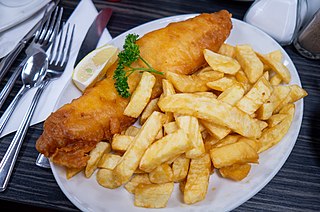
British cuisine is the specific set of cooking traditions and practices associated with the United Kingdom, including the cuisines of England, Scotland, Wales and Northern Ireland. According to food writer Colin Spencer, historically, British cuisine meant "unfussy dishes made with quality local ingredients, matched with simple sauces to accentuate flavour, rather than disguise it".
Awadhi cuisine is a cuisine native to the Awadh region in Northern India and Southern Nepal. The cooking patterns of Lucknow are similar to those of Central Asia, the Middle East, and Northern India and western India with the cuisine comprising both vegetarian and non-vegetarian dishes. The Awadh region has been influenced by Mughal cooking techniques, and the cuisine of Lucknow bears similarities to those of Central Asia, Kashmir, Punjab and Hyderabad. The city is also known for its Nawabi foods.

Tikka is a dish consisting of pieces of meat or vegetarian alternatives, with its origins tracing back to the ancient Babylon. The term 'tikka' was given in the mughal era. It is made by marinating the pieces in spices and yogurt, and cooking them in a tandoor. Tikka is popular throughout the Indian subcontinent and also in the United Kingdom.

Malaysian Indian cuisine, or the cooking of the ethnic Indian communities in Malaysia, consists of adaptations of authentic dishes from India, as well as original creations inspired by the diverse food culture of Malaysia. Because the vast majority of Malaysia's Indian community are of South Indian descent, and are mostly ethnic Tamils who are descendants of immigrants from a historical region which consists of the modern Indian state of Tamil Nadu and Sri Lanka's Northern Province, much of Malaysian Indian cuisine is predominantly South Indian inspired in character and taste. A typical Malaysian Indian dish is likely to be redolent with curry leaves, whole and powdered spice, and contains fresh coconut in various forms. Ghee is still widely used for cooking, although vegetable oils and refined palm oils are now commonplace in home kitchens. Before a meal it is customary to wash hands as cutlery is often not used while eating, with the exception of a serving spoon for each respective dish.
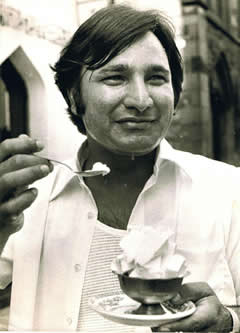
Ali Ahmed Aslam was a Pakistani–Scottish chef who is credited with inventing the dish chicken tikka masala.















